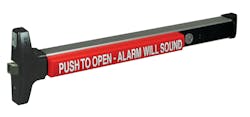Fire & Life Safety: Panic Hardware and Mag Locks
It is fundamentally against both the IBC and IFC codes to physically lock doors in occupied buildings — preventing occupants to freely exit in the case of a fire (Note: There are some exceptions, and a more complete explanation of them can be found in my “Back to Basics-Fire Exits” article in the Dec. 2014 issue of SD&I, available at www.securityinfowatch.com/12018700). In addition to codes, the issue of building security, in addition to fire safety, is also a concern for our customers. We will discuss some of those arrangements this month, especially how they relate to electromagnetic locks and panic hardware.
Panic Hardware
It is common practice to have panic hardware installed on exit doors from buildings so that the door’s push bar(s) is “dogged” down, causing it not to latch. This dogging feature allows people to exit through the door by pushing on it from the inside; and to enter the door by pulling a handle from the outside. Some panic hardware can have this feature performed remotely through the use of an optional electrical switch installed inside the push bar.
Manually un-dogging the door allows it to be secured from the outside yet enables the push bar to still function, allowing free egress (out) during an emergency. This manual un-dogging has been common in schools after the school day has begun, to protect the students and staff from persons who should not be allowed into the school. Legitimate visitors use an intercom to request entry during class hours, and after normal business hours — when educational (and assembly) occupancies have no occupants or are closed to all but night staff (typically custodians and cleaning personnel) — the doors can be dogged so they latch when closed.
Since fire-rated doors must automatically latch when closed, fire-rated doors cannot be fitted with the typical panic hardware described above.
Panic hardware is required to be installed on exits in “assembly occupancies” (i.e. movie theaters, museums, exhibit halls, night clubs, etc.) having an occupant load of 300 or more persons, as well as in “educational occupancies” with an occupant load of more than 50 persons (typically K-12 schools and daycare facilities), and the egress doors in these buildings may be fire-rated doors.
So how can this be accomplished within the scope of the IBC and still provide the users of these buildings with the features they need? Below is some additional information that will help sort this out.
Panic hardware is listed to UL305; however, this UL305 listing alone will not allow panic hardware to be installed on fire-rated doors. Fire-Rated doors, therefore, must be fitted with a special kind of panic hardware that is not just listed to UL305, but which also meets UL10C. This additional listing means that when this special kind of ‘fire exit hardware’ that serves as panic hardware is installed, the fire-rated doors will automatically latch in the closed position. This additional listing means that the fire-rated hardware will not allow the pressure created by a fire to push open the doors and compromise the fire areas they were installed to separate. And, because the fire exit hardware is listed to both UL305 and UL10C, it may be installed on non fire-rated exit doors as well.
Mag Locks
Electromagnetic locks, which are commonly provided and permitted in assembly and educational occupancies, allow free egress whereby a lever or push bar is used to directly interrupt the electrical power to the electromagnetic lock. A loss of power to this equipment must also automatically disable this lock.
Electromagnetic locks have no moving parts and are secured to the door frame so that they magnetically lock onto a steel plate that is bolted to the movable part of the door. These mag locks, as they are commonly referred to in the industry, are permitted provided all the requirements in 1008.1.9.9 of the 2012 edition of the IBC are met. These include the ability to operate the hardware with one hand, its operation unlocks the door without delay, loss of power to the equipment unlocks the door, and the method of operation is obvious under all lighting conditions.
Finally, and NEW to this edition of the IBC, is this last provision: “Where panic or fire exit hardware is required by Section 1008.1.10, operation of the listed panic or fire exit hardware also releases the electromagnetic locks.” This last and newest rule finally clarifies what had not been as obviously stated in the 2009 edition of the IBC/IFC — that fire-rated doors equipped with fire exit hardware may be provided on electromagnetically locked egress doors.
Since 1008.1.10 does require panic or fire exit hardware on doors with an occupant load of 50 or more in Group E and Day Care occupancies (and 300 or more in Group A buildings), and since electromagnetic locks are so common, this new wording in the IBC is helpful to alarm installers who are deploying them to satisfy their customers, but are having AHJs telling them they are not permitted.
The wording in previous editions of the IBC caused some inspectors to forbid mag locks in Schools/Day Cares and Assembly occupancies. This welcomed clarification in the 2012 edition of the IBC makes clear the intent of the code, and should close any back and forth discussions that may have taken place previously. For states that have yet to adopt the 2012 edition, it may help to point out this new clarifying entry to your inspector, when met with this predicament.
Greg Kessinger is SD&I’s fire alarm and codes expert and a regular contributor. Email him your fire & life safety questions [email protected].
About the Author

